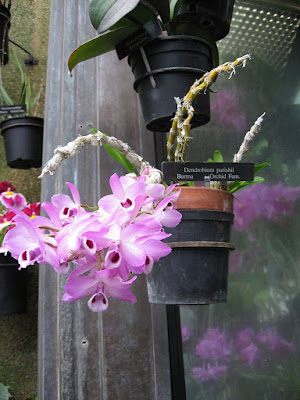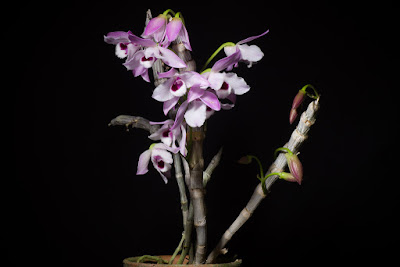Dendrobium parishii is native to Southeast Asia. These plants are widely distributed in the eastern Himalayas, from the Manipur region in north-east India, through the Burmese regions of Tenasserim, Maymyo and the Hills of China, northern and eastern Thailand, Laos, Vietnam to the Provinces of Yunnan and Gweizhou in southwest China...
Dendrobium parishii also called as Parish's Dendrobium, Callista parishii, Callista rhodopterygia, Dendrobium polyphlebium, Dendrobium rhodopterygium, is a species of the genus Dendrobium. This species was described by Heinrich Gustav Reichenbach in 1863.
IDENTIFY DENDROBIUM PARISHII
Dendrobium parishii is native to Southeast Asia. These plants are widely distributed in the eastern Himalayas, from the Manipur region in north-east India, through the Burmese regions of Tenasserim, Maymyo and the Hills of China, northern and eastern Thailand, Laos, Vietnam to the Provinces of Yunnan and Gweizhou in southwest China. In Thailand, they are found in dry deciduous forests at heights of 250-1700 m.
It is a small to medium sized, hot to cool growing epiphyte, which reaching 15-60 cm in size, with erect or downbent, yellowish, 15-60 cm long stems enveloped by white, membraneous sheaths carrying narrowly ovate to elliptic, obtuse, stiff, leathery, blunt, deciduous, 5-15 cm long leaves that are apically notched.
Parish's Dendrobium blooms from February through August with a peak season of May and June on a short, 2 to 3 flowered raceme with fragrant, long-lasting flowers that are borne at the nodes on the upper half of 2 year old, pendulous, leafless canes. The flowers are 4-6 cm in diameter. Their color is very changeable. The flakes of both whorls are often dark pink and paler near the center. The inner whorl flakes are finely serrated. The dark pink lip is covered with hairs on the upper surface, has dark purple spots inside and 2 deep purple spots on each side of the throat. It is shorter than the petals of both whorls. The spine is white.
DENDROBIUM PARISHII CARE AND CULTURE
Cultural information should only be used as a guide, and should be to be adapted to suit you. Your physical location; where you grow your plants, how much time you have to devote to their care, and many other factors, will need to be taken into account. Only then can you decide on the cultural methods that best suit you and your plants.
Light:
Dendrobium parishii needs a light level of 20000-30000 lux. Shading is required from spring until autumn, but the light level should be as high as the plant can tolerate without leaf burns. The constant, strong air movement is very important.
Temperature:
The average temperature of the summer day is 25-26 ° C, the night 17-18 ° C, giving a daily difference of 7-8 ° C. In spring, the average day temperature is 29-31 ° C, the night 11-18 ° C, which gives a daily difference of 11-20 ° C. In winter, the average day temperature is 23-26 ° C, night 8-9 ° C, giving a daily difference of 14-18 ° C.
Humidity:
From summer to autumn, Parish's Dendrobium needs the humidity of 80-85%, but for most of the remaining period it drops to 60-70%. During the 2 spring months, the conditions are very dry and the humidity drops to 50%.
Substrate, growing media and repotting:
These plants grow well in pots, baskets, or mounted on tree fern rootstock. When growing in pots, any loose, quickly drying substrate is recommended. Repotting is best done in early spring, when new roots begin to grow.
Watering:
During the growing season, Dendrobium parishii should be watered abundantly, but when new growths reach maturity in autumn, the amount of water should be gradually reduced.
Fertilizer:
It is recommended to apply a 1/4-1/2 dose of orchid fertilizer weekly. From spring to mid summer, fertilizer with an increased nitrogen content is preferred, and fertilizer with an increased content of phosphorus should be used at the end of summer and autumn.
Rest period:
Dendrobium parishii should be limited to the amount of water from late autumn to the beginning of spring. For most of the winter, the plants should dry out between waterings, but they can not stay dry for too long. Occasional morning fogging between waterings will help protect the plants from dehydration. For a period of 1-2 months at the end of winter, the amount of water should be limited to the occasional morning fogging. Fertilization should be reduced or eliminated until new growth appears in the spring.















COMMENTS